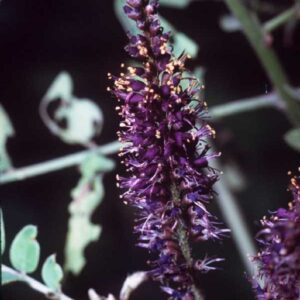Showing the single result
False Indigo Bush
Cold Stream Farm grows and sells wholesale and retail False Indigo shrubs from our facilities in Free Soil, Michigan. We carry False Indigo (Amorpha fruticosa) bare root seedlings and transplants of various sizes. Our team ships orders throughout North America, with restrictions on False Indigo shipments to the state of Maine.
There is no minimum order size for our False Indigo plants, and seeds or transplants can be shipped along with various plants of other species.
False Indigo Bush Facts & Details
False Indigo is a common name used to describe plants that belong to the genus of Amorpha. Amorpha plants are called “False” Indigo due to their resemblance to Indigofera tinctoria, otherwise known as “True” Indigo. Often referred to simply as “Indigo,” Indigofera tinctoria remains one of the most commonly used plants in modern dye-making.
We sell Amorpha fruticosa, which is commonly known as false indigo bush, desert false indigo, or bastard indigo bush. Desert false indigo is native to North America, growing naturally from northern Mexico to southeastern Canada by way of the contiguous United States.
Appearance, Size, and Shape
False Indigo bushes are recognized for their single-petal flowers bearing the bright color for which the plant is named. In rich blue-purple hues, false indigo blooms grow vertically with a close resemblance to real indigo flowers.
Amorpha fruticosa produces spike-like purple flowers with yellow anthers crowning outward. Aesthetically please, these false indigo plants are typically grown ornamentally.
Mature false indigo bushes reach 10 to 15 feet in height with widths up to 30 feet in length. In general, a false indigo bush grows to be about twice as wide as it is tall, supporting its flowers with arching, green-leaf bearing branches.
Best Conditions for Growing False Indigo
Highly resilient, false indigo plants are not very demanding and able to withstand nutritionally-poor soil as well as periods of extended drought. False indigo can perform well in dry or moist soil and is most suitable for sandy or loamy conditions.
Full sun is ideal for growing False Indigo. Although the plant can tolerate a bit of shade, the best results typically come from full-sun exposure. False Indigo plants are typically very tolerant of humid and cool-weather conditions.
Livable in all 48 contiguous United States, False Indigo can grow in USDA zones 3-10. Depending on the space, plants are typically placed 10 to 15 feet from one another.
Pros, Benefits, and Uses
Above all, False Indigo is used as an ornamental plant to bring color and cover to an outdoor area. As the plants tend to “grow like a weed,” this makes it easy to quickly transform an outdoor space with a few false indigo plants.
Beyond residential and commercial use, False Indigo is commonly used as a highway shrub, because it is very resistant to salt and poor soil conditions. Medically, rotenoids from False Indigo plants have been lauded for the ability to counteract diabetes and metabolic syndrome.
Ecology
Nectar-rich flowers on false indigo bushes tend to attract butterflies, bees, and other nectar-hungry insects. Amorpha fruticosa is well-known for hosting moth larva, attracting species such as Io moths, clouded sulfurs, silver-spotted skippers, gray hairstreaks, marine blues, hoary edges, and southern dogfaces.
Cons, Disadvantages, and Considerations
In some areas of the world, wild false indigo has only spread after being introduced invasively. False Indigo may not be legal to plant on certain properties to protect native species.
If there is not enough airflow or sunlight on an indigo bush, damp and humid conditions may cause rusting or over-accumulation of mildew. Fungus-related diseases will quickly eat away at false indigo leaves, and caretakers should keep a close eye out for weevils and other small pests.
Planting and Maintaining False Indigo Bushes
To reach its mature height, a false indigo plant will typically take about a year to completely fill out. Flowers are first seen in a false indigo’s second or third year, with blossoms blooming in April, May, and June.
By winter, most parts of a false indigo bush die, with leaves turning black before collapsing. For this reason, most people trim down their indigo bushes each fall. It is not advisable to bring false indigo plants indoors.
Propagating False Indigo is most easily accomplished with cuttings or transplants. False Indigo seeds have a hard, protective casing which may require preparation in the form of hot water soaking or scarification.
In the wild, false indigo plants thrive most alongside streams in loose airy thickets, so replicating these conditions is ideal. A healthy plant will bear small fruits that can grow to be up to approximately 3/8″ long.
Buy False Indigo from our headquarters in Michigan
For wholesale and retail False Indigo, you may place an order with Cold Stream Farm at no product minimum. Order online or contact us today to get started with your order of False Indigo seedlings or bare root seedlings.


